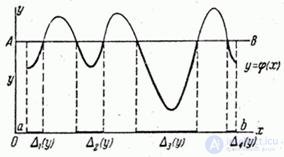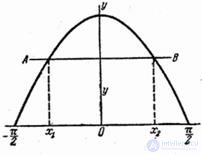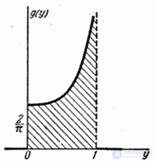Lecture
There is a continuous random variable  with distribution density
with distribution density  ; other value
; other value  associated with
associated with  functional dependence:
functional dependence:
 ,
,
and function  Location on
Location on  possible values of the argument are not monotonous (Fig. 12.3.1).
possible values of the argument are not monotonous (Fig. 12.3.1).

Fig. 12.3.1.
Find the distribution function  magnitudes
magnitudes  . To do this, again, hold the line
. To do this, again, hold the line  parallel to the abscissa at a distance
parallel to the abscissa at a distance  from it and select those parts of the curve
from it and select those parts of the curve  on which the condition is met
on which the condition is met  . Let these sections correspond to the sections of the x-axis:
. Let these sections correspond to the sections of the x-axis: 
Event  tantamount to hitting a random variable
tantamount to hitting a random variable  on one of the sites
on one of the sites  - all the same on which one. therefore
- all the same on which one. therefore

 .
.
Thus, for the distribution function of  we have the formula:
we have the formula:
 . (12.3.1)
. (12.3.1)
Spacing boundaries  depends on
depends on  and given the specific form of the function
and given the specific form of the function  can be expressed as explicit functions
can be expressed as explicit functions  . Differentiating
. Differentiating  by size
by size  entering the limits of integrals, we obtain the distribution density of
entering the limits of integrals, we obtain the distribution density of  :
:
 . (12.3.2)
. (12.3.2)
Example. Magnitude  subject to the law of uniform density in the area from
subject to the law of uniform density in the area from  before
before  :
:

Find the law of distribution of magnitude  .
.
Decision. Build a graph of the function  (fig. 12.3.2). Obviously
(fig. 12.3.2). Obviously  ,
,  and in the interval
and in the interval  function
function  not monotonous.
not monotonous.

Fig. 12.3.2.
Applying the formula (12.3.1), we have:
 .
.
Express limits  and
and  through
through  :
:
 ;
;  .
.
From here
 . (12.3.3)
. (12.3.3)
To find the density  We will not calculate the integrals in the formula (12.3.3), but directly differentiate this expression with respect to the variable
We will not calculate the integrals in the formula (12.3.3), but directly differentiate this expression with respect to the variable  within the integrals:
within the integrals:
 .
.
Bearing in mind that  , we get:
, we get:
 . (12.3.4)
. (12.3.4)
Pointing for  distribution law (12.3.4), it should be stipulated that it is valid only in the range from 0 to 1, i.e. within the limits in which it changes
distribution law (12.3.4), it should be stipulated that it is valid only in the range from 0 to 1, i.e. within the limits in which it changes  with argument
with argument  between
between  and
and  . Beyond these limits the density
. Beyond these limits the density  equals zero.
equals zero.
Function graph  given in fig. 12.3.3. With
given in fig. 12.3.3. With  curve
curve  has a branch going to infinity.
has a branch going to infinity.

Fig. 12.3.3.
Comments
To leave a comment
Probability theory. Mathematical Statistics and Stochastic Analysis
Terms: Probability theory. Mathematical Statistics and Stochastic Analysis